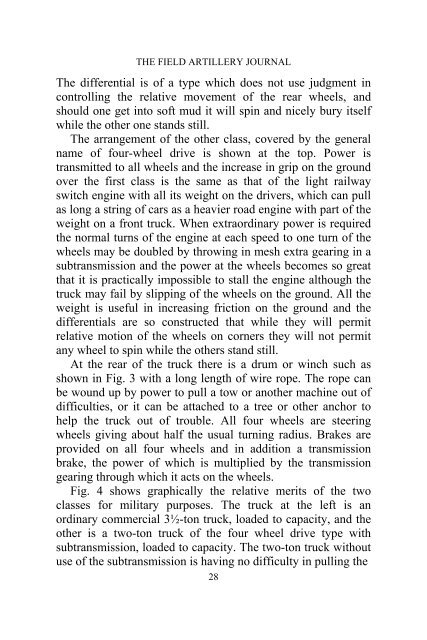the field artillery journal - Fort Sill - U.S. Army
the field artillery journal - Fort Sill - U.S. Army
the field artillery journal - Fort Sill - U.S. Army
Create successful ePaper yourself
Turn your PDF publications into a flip-book with our unique Google optimized e-Paper software.
THE FIELD ARTILLERY JOURNAL<br />
The differential is of a type which does not use judgment in<br />
controlling <strong>the</strong> relative movement of <strong>the</strong> rear wheels, and<br />
should one get into soft mud it will spin and nicely bury itself<br />
while <strong>the</strong> o<strong>the</strong>r one stands still.<br />
The arrangement of <strong>the</strong> o<strong>the</strong>r class, covered by <strong>the</strong> general<br />
name of four-wheel drive is shown at <strong>the</strong> top. Power is<br />
transmitted to all wheels and <strong>the</strong> increase in grip on <strong>the</strong> ground<br />
over <strong>the</strong> first class is <strong>the</strong> same as that of <strong>the</strong> light railway<br />
switch engine with all its weight on <strong>the</strong> drivers, which can pull<br />
as long a string of cars as a heavier road engine with part of <strong>the</strong><br />
weight on a front truck. When extraordinary power is required<br />
<strong>the</strong> normal turns of <strong>the</strong> engine at each speed to one turn of <strong>the</strong><br />
wheels may be doubled by throwing in mesh extra gearing in a<br />
subtransmission and <strong>the</strong> power at <strong>the</strong> wheels becomes so great<br />
that it is practically impossible to stall <strong>the</strong> engine although <strong>the</strong><br />
truck may fail by slipping of <strong>the</strong> wheels on <strong>the</strong> ground. All <strong>the</strong><br />
weight is useful in increasing friction on <strong>the</strong> ground and <strong>the</strong><br />
differentials are so constructed that while <strong>the</strong>y will permit<br />
relative motion of <strong>the</strong> wheels on corners <strong>the</strong>y will not permit<br />
any wheel to spin while <strong>the</strong> o<strong>the</strong>rs stand still.<br />
At <strong>the</strong> rear of <strong>the</strong> truck <strong>the</strong>re is a drum or winch such as<br />
shown in Fig. 3 with a long length of wire rope. The rope can<br />
be wound up by power to pull a tow or ano<strong>the</strong>r machine out of<br />
difficulties, or it can be attached to a tree or o<strong>the</strong>r anchor to<br />
help <strong>the</strong> truck out of trouble. All four wheels are steering<br />
wheels giving about half <strong>the</strong> usual turning radius. Brakes are<br />
provided on all four wheels and in addition a transmission<br />
brake, <strong>the</strong> power of which is multiplied by <strong>the</strong> transmission<br />
gearing through which it acts on <strong>the</strong> wheels.<br />
Fig. 4 shows graphically <strong>the</strong> relative merits of <strong>the</strong> two<br />
classes for military purposes. The truck at <strong>the</strong> left is an<br />
ordinary commercial 3½-ton truck, loaded to capacity, and <strong>the</strong><br />
o<strong>the</strong>r is a two-ton truck of <strong>the</strong> four wheel drive type with<br />
subtransmission, loaded to capacity. The two-ton truck without<br />
use of <strong>the</strong> subtransmission is having no difficulty in pulling <strong>the</strong><br />
28

















